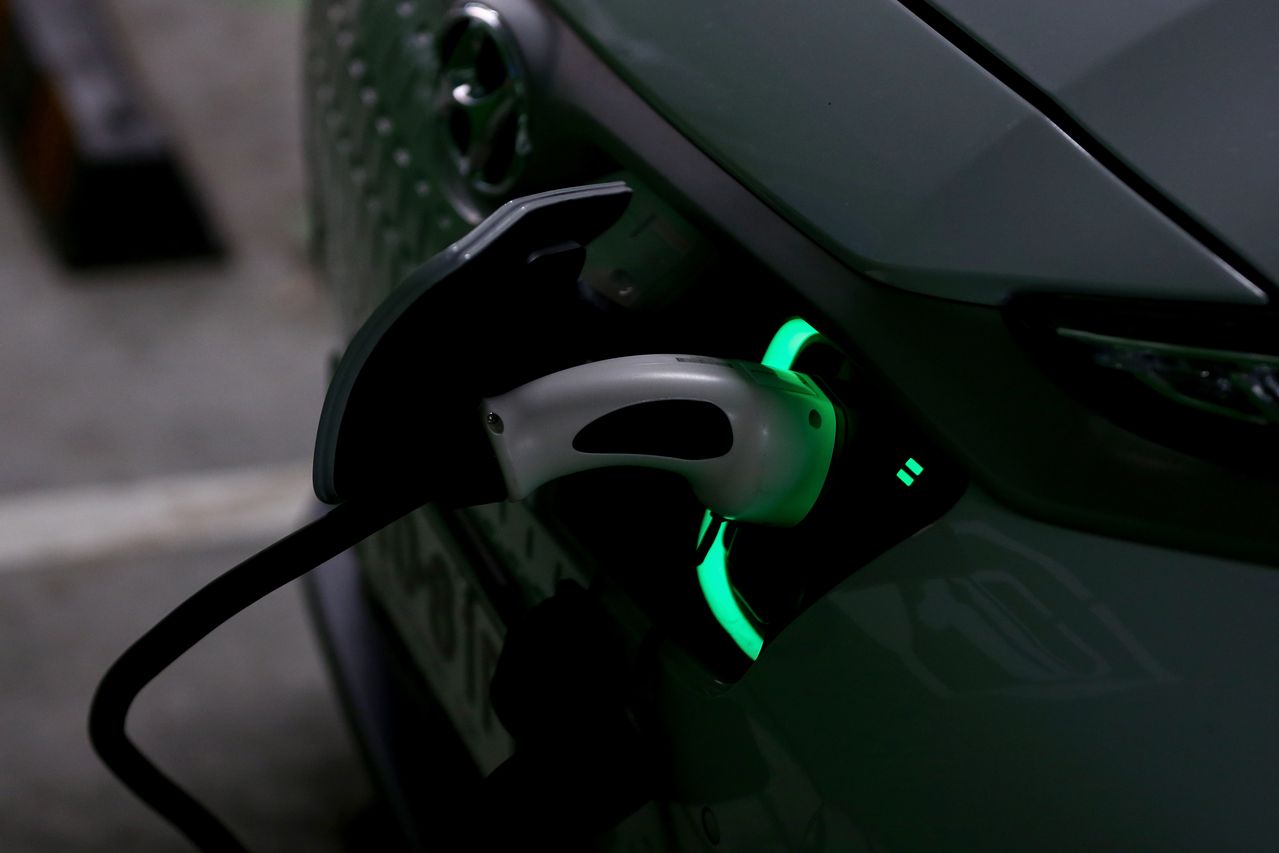General Motors shook up the car industry this past week, saying it is aiming to stop selling gasoline-powered cars by 2035, much sooner than many on Wall Street would have predicted.
It is a sign that analysts and investors should be sharpening their pencils to figure out what is likely—and what is possible—for global electric-vehicle demand. The results of that number crunching will help to show whether the market has valued highflying EV stocks correctly and which, if any, still offer good value.
It isn’t an easy equation to solve. Auto makers express their goals—one indication of what might happen in the market—in different ways.
General Motors (ticker: GM) has its target for 2035. Tesla (TSLA) CEO Elon Musk has talked about selling 20 million EVs by 2030 and plans to increase its production volume at 50% a year for the foreseeable future.
Volkswagen (VOW. Germany) wants up to 25% of vehicle sales to come from battery-powered electric vehicles by 2030. And Toyota (TM) plans to sell 5.5 million electrified vehicles by 2030—a figure that includes hybrid electric cars as well as fuel-cell vehicles.
Barron’s added up the numbers in the publicly announced goals, aligning them by year and filling in some gaps. We calculate that, based on company comments, somewhere between 15 million and 20 million EVs will be sold a year by 2025. That implies an average annual growth rate of about 50% between last year and then. With that growth, EVs would account for roughly 15% to 20% of total light-vehicle sales.
Wedbush analyst Dan Ives qualifies as an electric-vehicle bull, but his estimate of EVs’ share of the market isn’t that high. “I am laser-focused on the skyrocketing EV demand out of China, Biden green initiatives, and [battery innovation] across the EV supply chain,” he tells Barron’s. “It looks like a golden age for EVs.”
Still, he is assuming EVs will win about 10% of the global market by 2025.
Focusing on China is a good idea. It’s the largest new-car market in the world and government incentives make buying an EV a “no brainer” for most consumers, according to Ives. Goldman Sachs analyst Fei Fang has predicted EVs will have 20% of the Chinese market by 2025.
RBC analyst Joseph Spak recently projected battery- and hybrid-electric vehicles could account for roughly 15% of new-car sales by 2025. That call was made back in December, before GM announced its aspiration to be all-electric by 2035.
Now Spak believes his projection could be too low. He did his own math to illustrate why.
“GM historically has had [about] 17% total U.S. market share,” he wrote in a recent research note. In December, he expected EVs to account for 40% of U.S. new-car sales by 2035. But for GM to go all-electric by then, assuming it keeps its historic 17% of the market, it would have to win 43% of U.S. EV sales, he said.
“The other way to interpret this [math] is that there could be upside to our 40% [battery electric] mix assumption,” added the analyst. That would be bullish for EV stocks, but he has a word of caution too. “A massive ramp in battery supply is needed to support this,” he said.
That gets at another important point for investors. There are many tertiary effects from faster EV penetration.
For one, as EVs take a bigger share of the market, they will start to get more of the capital the industry is willing to spend on product development. GM, for instance, is spending about half its capital over the next few years on EV and autonomous-driving technologies. By 2030, cars powered by internal combustion engines—ICE cars, in industry jargon—won’t look as attractive, relatively speaking, as those programs are drained of resources.
Electricity infrastructure is another critical issue. Right now oil and the refining industry essentially power cars. In the future, utilities and the electric grid will bear the burden.
The math needed to predict global electricity demand is harder, but higher EV penetration in 2025 would probably boost growth, now at roughly 3% a year, by a couple of percentage points. That seems manageable, but it means more investment in utilities.
The other side off the electricity equation is oil. Oil demand could fall slightly compared with 2019, a pre-pandemic year, if the world’s pool of EVs grows faster than expected. There are roughly 2 billion light vehicles on the road and nearly all take gasoline.
The next step in this math class is to value the EV sector. That isn’t easy either.
Given the growth and accelerating penetration, figures for 2025, when EV companies should be making real money, seem like a reasonable place to start. Apple (AAPL), the world’s most valuable company, trades for about 19 times estimated 2025 cash flow of about $120 billion.
Tesla is trading for about 65 times estimated 2025 cash flows. That is triple the figure for Apple, although if Musk’s goals are met, Tesla’s annual sales will go from more than 4 million vehicles to about 20 million over the next five years—between 2025 and 2030.
China’s NIO (NIO) is another highly valued EV stock. Analysts haven’t made public projections for its 2025 financials. But its shares trade for about 30 times estimated 2024 cash flow. According to analysts, NIO vehicle shipments are expected to go from roughly 345,000 to about 800,00 from 2025 to 2030. That is less growth than Tesla is looking to produce, but it still implies sales would more than double.
The 2025 valuation math can’t tell investors to buy or sell the stock, or the sector, but it does offer context about the coming golden age of EVs. Tesla stock is up about 21% year to date. NIO shares are up almost 19%. The S&P 500 is up about 2%.
Investors expect a lot. Morgan Stanley’s Adam Jonas pointed out that January EV sales in the U.S. were still less than 3% of the total, but he isn’t an EV bear. He rates Tesla stock at Buy and has a target of $880 for the stock-price target.
The ICE Age is ending. If the switch to EVs is rapid, valuations for manufacturers might not be unreasonable. The effects on other industries are just starting to be felt.
 Copyright 2020, Dow Jones & Company, Inc. All Rights Reserved Worldwide. LEARN MORE
Copyright 2020, Dow Jones & Company, Inc. All Rights Reserved Worldwide. LEARN MORE
What a quarter-million dollars gets you in the western capital.
Alexandre de Betak and his wife are focusing on their most personal project yet.
As Paris makes its final preparations for the Olympic games, its residents are busy with their own—packing their suitcases, confirming their reservations, and getting out of town.
Worried about the hordes of crowds and overall chaos the Olympics could bring, Parisians are fleeing the city in droves and inundating resort cities around the country. Hotels and holiday rentals in some of France’s most popular vacation destinations—from the French Riviera in the south to the beaches of Normandy in the north—say they are expecting massive crowds this year in advance of the Olympics. The games will run from July 26-Aug. 1.
“It’s already a major holiday season for us, and beyond that, we have the Olympics,” says Stéphane Personeni, general manager of the Lily of the Valley hotel in Saint Tropez. “People began booking early this year.”
Personeni’s hotel typically has no issues filling its rooms each summer—by May of each year, the luxury hotel typically finds itself completely booked out for the months of July and August. But this year, the 53-room hotel began filling up for summer reservations in February.
“We told our regular guests that everything—hotels, apartments, villas—are going to be hard to find this summer,” Personeni says. His neighbours around Saint Tropez say they’re similarly booked up.
As of March, the online marketplace Gens de Confiance (“Trusted People”), saw a 50% increase in reservations from Parisians seeking vacation rentals outside the capital during the Olympics.
Already, August is a popular vacation time for the French. With a minimum of five weeks of vacation mandated by law, many decide to take the entire month off, renting out villas in beachside destinations for longer periods.
But beyond the typical August travel, the Olympics are having a real impact, says Bertille Marchal, a spokesperson for Gens de Confiance.
“We’ve seen nearly three times more reservations for the dates of the Olympics than the following two weeks,” Marchal says. “The increase is definitely linked to the Olympic Games.”

Getty Images
According to the site, the most sought-out vacation destinations are Morbihan and Loire-Atlantique, a seaside region in the northwest; le Var, a coastal area within the southeast of France along the Côte d’Azur; and the island of Corsica in the Mediterranean.
Meanwhile, the Olympics haven’t necessarily been a boon to foreign tourism in the country. Many tourists who might have otherwise come to France are avoiding it this year in favour of other European capitals. In Paris, demand for stays at high-end hotels has collapsed, with bookings down 50% in July compared to last year, according to UMIH Prestige, which represents hotels charging at least €800 ($865) a night for rooms.
Earlier this year, high-end restaurants and concierges said the Olympics might even be an opportunity to score a hard-get-seat at the city’s fine dining.
In the Occitanie region in southwest France, the overall number of reservations this summer hasn’t changed much from last year, says Vincent Gare, president of the regional tourism committee there.
“But looking further at the numbers, we do see an increase in the clientele coming from the Paris region,” Gare told Le Figaro, noting that the increase in reservations has fallen directly on the dates of the Olympic games.
Michel Barré, a retiree living in Paris’s Le Marais neighbourhood, is one of those opting for the beach rather than the opening ceremony. In January, he booked a stay in Normandy for two weeks.
“Even though it’s a major European capital, Paris is still a small city—it’s a massive effort to host all of these events,” Barré says. “The Olympics are going to be a mess.”
More than anything, he just wants some calm after an event-filled summer in Paris, which just before the Olympics experienced the drama of a snap election called by Macron.
“It’s been a hectic summer here,” he says.

AFP via Getty Images
Parisians—Barré included—feel that the city, by over-catering to its tourists, is driving out many residents.
Parts of the Seine—usually one of the most popular summertime hangout spots —have been closed off for weeks as the city installs bleachers and Olympics signage. In certain neighbourhoods, residents will need to scan a QR code with police to access their own apartments. And from the Olympics to Sept. 8, Paris is nearly doubling the price of transit tickets from €2.15 to €4 per ride.
The city’s clear willingness to capitalise on its tourists has motivated some residents to do the same. In March, the number of active Airbnb listings in Paris reached an all-time high as hosts rushed to list their apartments. Listings grew 40% from the same time last year, according to the company.
With their regular clients taking off, Parisian restaurants and merchants are complaining that business is down.
“Are there any Parisians left in Paris?” Alaine Fontaine, president of the restaurant industry association, told the radio station Franceinfo on Sunday. “For the last three weeks, there haven’t been any here.”
Still, for all the talk of those leaving, there are plenty who have decided to stick around.
Jay Swanson, an American expat and YouTuber, can’t imagine leaving during the Olympics—he secured his tickets to see ping pong and volleyball last year. He’s also less concerned about the crowds and road closures than others, having just put together a series of videos explaining how to navigate Paris during the games.
“It’s been 100 years since the Games came to Paris; when else will we get a chance to host the world like this?” Swanson says. “So many Parisians are leaving and tourism is down, so not only will it be quiet but the only people left will be here for a party.”















